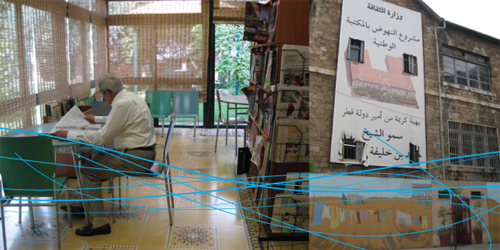- HOME
- ABOUT US
- NEWSLETTER
- CONTACT
- MAST
- GREEN ISLAND
- GOING PUBLIC '03
- GOING PUBLIC '04
- GOING PUBLIC '05/1
- GOING PUBLIC '05/2
- GOING PUBLIC '06
- GOING PUBLIC '08
- E.T.U.
- BORDER ZONES
- RE-THINKING BEIRUT
- ART AS DOCUMENT
- NEW CITY-TERRITORY
- COMMUNITIES & TERRITORIES
- TANGER TANGER
- PUBLICATIONS
- PRESS
- NETWORK & PARTNERS
- ARTISTS & CONTRIBUTORS

Communities and Territories Beirut
On Public Sphere & Public Library November/December 2007- Beirut, Lebanon
The week of meetings, lectures and workshops in Beirut on the theme of “Public Space/Private Space” has come to a close.
A project by aMAZElab, Milan (Italy), under the artistic direction of Claudia Zanfi.
The “Communities and Territories” project, which opened on 17th November with a seminar at the American University of Beirut (AUB) and continued with a series of three workshops in the three public libraries of the city, was received with numerous and wide-ranging participation, making it a project of great worth, also thanks to the presence of speakers and artists of international fame. The heart of the project lay in the three different libraries to be found in different areas of the city: Bachoura (to the West), Geitawi (to the East) and Haret Hreik (to the South). Not only do these represent the territorial differences of the complex Lebanese situation, but also the cultural, political and social diversities of the country.
The aims of bringing about the interaction between and sharing of different experiences, cultures, and knowledge in order to provide an injection of new ideas, proposals and projects for the city were undoubtedly achieved.
For the first time after the war in the summer of 2006, an international cultural workshop was set up in the area south of Beirut. The workshop, chaired by the Lebanese architect NADIM KARAM with the support of the New York artist/architect VITO ACCONCI, was entitled “A City for All”, a survey of the public space of the city aimed at providing a collective proposal for its future. The workshop was held at the Centre de Lecture et d’Animation Culturel (CLAC) of Haret Hreik, a Shiite Muslim suburb to the south of the city, badly damaged by bombing last summer, and home to Hezbollah’s head quarters.
Here the participants based their contributions on their direct experiences during the tours of the area and their meetings with the local community. As suggested by Vito Acconci, the group was encouraged to think up an “immaterial” project, a form of “non-architecture”, a kind of “artistic non-installation”, but rather a “party”, a meeting place, with the use of music. This was the thinking behind the “WALIMEH”, an Arabic party, a sort of “stand/feast” around which various activities are carried out. Food and drink were provided under a tent; a “cabinet de photo mobile” was set up in order to gather images and portraits of the community, which were printed and gifted to the participants on the same day; the event was also accompanied by music, dancing, and video projections. At the end of the project, the group produced a video as well as a large-scale (senti)mental map of the neighbourhood.
The “City Tags” workshop, held by artist Calin Dan (Netherlands) and graphic designer Alfred Tarazi (Lebanon), focused on the notion of the subjective mapping of the city of Beirut. The participants, from artists to students and designers, created a tabloid to be left in the rooms of the Geitawi library. Every page presented a series of stories, photographs, drawings, collages, telling both collective and private tales, anecdotes, accounts of city life. And so the imaginary journey through the city covers 16 pages, guided by the memories of those who wrote, draw or painted them.
Another workshop, “Art for change”, set out to explore the areas of contact between different communities through a series of visual stimuli (photographs, videos, interviews), outlining territorial diversity in political, social and cultural terms. Held by the English artist Loraine Leeson as well as the Lebanese writer Bilal Khbeiz at the Bachoura public library, this workshop produced two different works: the first, “Abbandoned Memories”, brings together a series of images on the memories of abandoned places. The second “A Question of Identity” deals with a series of posters placed in the public spaces of the city on the theme of identity.
To round off the week’s appointments, a public debate was held, including the presentation of all visual materials produced, at the “Zico House” Cultural Centre of Beirut, which continues to house an exhibition of photographs, maps and posters: the outcome of the three workshops (on display until 15th December 2007).
A book including critical and theoretical writings, together with texts by the local communities and visual materials, will be published in Spring 2008.
Project sponsored by: the Heinrich Böll Foundation, Middle East Office, Beirut
In collaboration with: Assabil; AUB (American University of Beirut); CLAC, Haret Hreik
With the support of: British Council; Istituto Italiano di Cultura; Ford Foundation; Seydoux Foundation; Mondriaan Foundation .
- info@amaze.it - www.amaze.it
![]()
![]()
